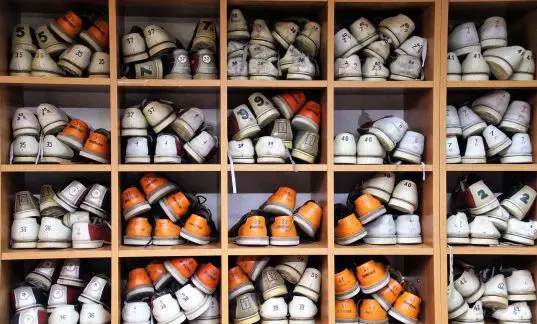If you’re heard the term full-rollers around your local bowling alley but aren’t sure what that means exactly, you’re not alone. While it’s common for bowlers to chat about different bowling ball grips and the effect of how you place your fingers and thumb in the finger holes and thumb holes respectively, it’s less popular to talk about ball rolls and ball track changes.
We’re here to change the narrative and help you find the right bowling ball roll for a straight ball, a spare ball, and a hooking strike. And we’re also here to shed some light on the somewhat rare full-roller release and how such a throw affects your entry angles and overall hitting power.
First, let’s examine the three common types of bowling ball rolls. We’ll look at where each roll’s ball track is located compared to finger and thumb placement, which ball roll styles promise more revolutions, and what rolling over the entire circumference of a ball does to a player’s shot.
What are the three basic types of roll for bowling balls?
Spinner Layout
The spinner layout uses a very small portion of the circumference of the ball to put together a roll. To create a spinner shot, a bowler twists their wrist and turns their thumb down sharply at the ball’s release point. By doing this, you can spin a ball like a top down a bowling lane with a high rev rate. Spinners often use a balance hole (if allowed) to promote spin down-lane, and the twist of the thumb hole allows for stability when extreme hooks are called for. It is hard to maintain consistent force and entry angles to the pin pocket with this, the trickiest of ball layouts. But, the lengthy distance between the ball track and the thumb and finger holes causes some crazy spins in the middle of bowling lanes.
Semi-Roller Layout
One of the most versatile and effective roll layouts in terms of axis tilt and hitting power, semi-roller bowling is a trademark of many PBA Tour bowlers. It uses more of the circumference of the ball than a spinner layout but doesn’t use the full circumference like a full-roller layout. It doesn’t have a particularly high track. It uses a more balanced grip center to create a ball track around 25 inches or so. To create a semi-roller bowling roll, a bowler creates a counter-clockwise ball turn by turning the throwing hand and arm that same way. To maximize your hooks and your control at the same time with the pops of your thumb, ring finger, and pointer, a semi-roller layout is probably the best way to go.
Full-Roller Layout
People assume off the bat that the full-roller layout is antiquated and out of practice. But, that’s not true. In fact, full-roller bowling is still alive and well at bowling centers and tournaments around the world.
What is full-roller bowling?
Popular among older bowlers and Senior League standouts, the full-roller layout uses all or most of the 27 inches of circumference of a bowling ball. Rather than turning your hand counter-clockwise like a right-handed semi-roller, a full-roller sacrifices hook and power for control with a clockwise turn of the throwing hand. To put a full roll on a bowling ball, place your throwing hand to the side of the ball or just in front of it during the downswing process.
When delivering the ball, open your hand slightly with the thumb hole and your thumb somewhere around 10 to 12 o’clock. At the release of your thumb, lift your fingers to create a counter-clockwise rotation on your bowling ball. Your hand should be turning clockwise during the follow-through of your swing.
How does full-roller bowling affect the roll of a bowling ball?
When you approach the foul line as a full-roller, entry angles to the pin pocket open up considerably. Especially if you use a ball with a symmetrical core, your hook will be limited. But, your straight-line control in oily conditions will be increased — especially if you keep your hand straight to and through your release. When you bowl over the entire circumference of a ball, speed is secondary to pinpoint accuracy. And that can be both a good thing and a bad thing.
What are the advantages of a full-roller layout?
The full-roller bowling layout is a shining example of what a controlled throw can do for talented bowlers. Because of the consistency of the roll and the high track, full-roller shots don’t have the Dr. Jekyll and Mr. Hyde tendencies of semi-roller and spinner shots. Even when oil conditions get deep and complex, rolling a ball over its full circumference increases the amount of surface area that touches the lane in a given shot. By doing so, you add stability to a shot that could otherwise go haywire when things start slipping and sliding.
If you’re playing a Scotch Doubles game and are stuck picking up spares for your team, a full-roller throwing approach might be beneficial. You’ll sacrifice overall hook potential for straight-line control, and that control will help you convert spare opportunities to keep your team in the game. And if you’re looking for an optimum single lane of entry to the pin pocket, a balanced full-roller throw can do just that. You won’t come into the pocket sharply and with creative vigor, but you can learn to hit the pins correctly the same way most of the time.
For older bowlers who don’t have the arm strength and dexterity of years past, a full-roller approach can be really helpful. You don’t have to violently jerk and twist your arm as you do as a semi-roller or spinner, and you can put a natural decrease in power aside in favor of a more controlled finish through the pins.
What are the disadvantages of a full-roller delivery?
A full-roller won’t be able to match the sheer power that a semi-roller generates to and through the pins. By playing with a full-roller approach, large ball tracks decrease the amount of oomph and explosiveness you can generate at pin impact. And while a full-roller throw creates some standard left-to-right hooking action, sharpness is muted and overall violence is downgraded.
In short, the boom/bust potential of a semi-roller in terms of pure scoring ability isn’t as prominent for full-roller bowlers. Some full-rollers counterbalance this by pushing through the release with added strength, upping the side roll of the ball with an added counter-clockwise turn. Yet, it’s still not going to give you the creativity and angles that a semi-roller or spinner ball track will.
Are there any professional bowlers who use full-roller layouts?
For PBA Tour bowling fans in the know, we can rephrase this question thusly…
Is Tom Smallwood actually a full roller?
Yes! While the full-roller bowling style is much more common on senior circuits than in the top men’s and women’s bowling associations, two-time major PBA tournament winner Tom Smallwood is one of the exceptions. The veteran right-hander has used a full-roller delivery since his rookie year of 2009-10 and has been successful in doing so! He has three PBA Tour victories to his credit including the two aforementioned major wins. He also has five PBA Regional Tour wins on his record and has finished as the runner-up in two other major PBA tourneys.
With 11 recorded 300-games to his credit, Smallwood has parlayed his PBA Tour success to become a pro staff member for Turbo Grips and Motiv Bowling.
Can a full-roller bowler succeed in today’s game?
Yes! While there are some inherent struggles for full-roller deliveries in their hook-heavy times, a talented bowler is still a talented bowler. If you can make the most out of a controlled full-roller delivery and see your scores increase when you use the full circumference of a ball, go with it! Just because the vast majority of pro bowlers don’t subscribe to your methodology doesn’t mean it can’t work.


